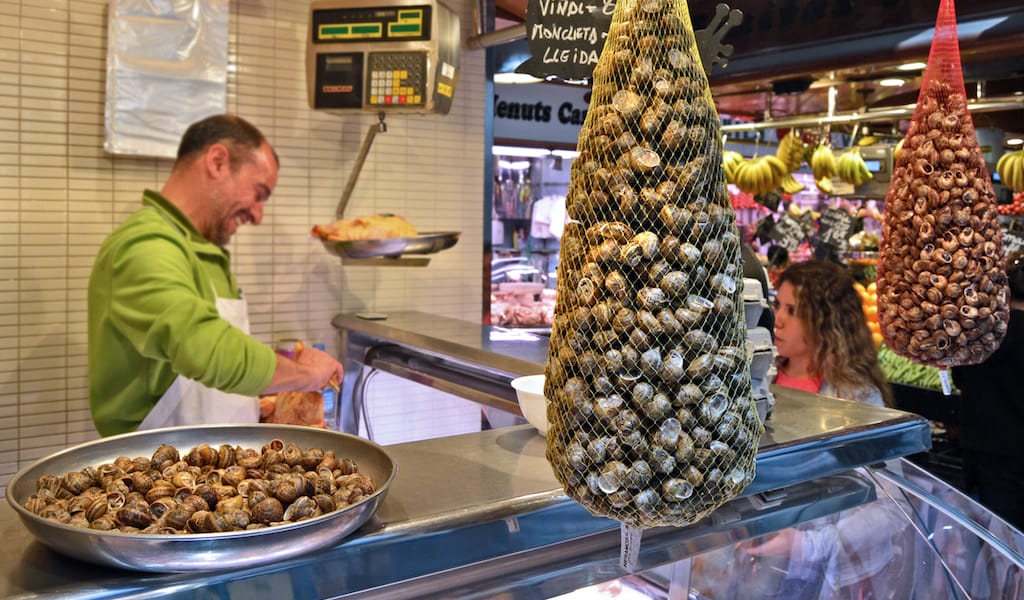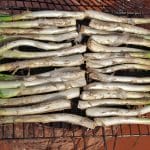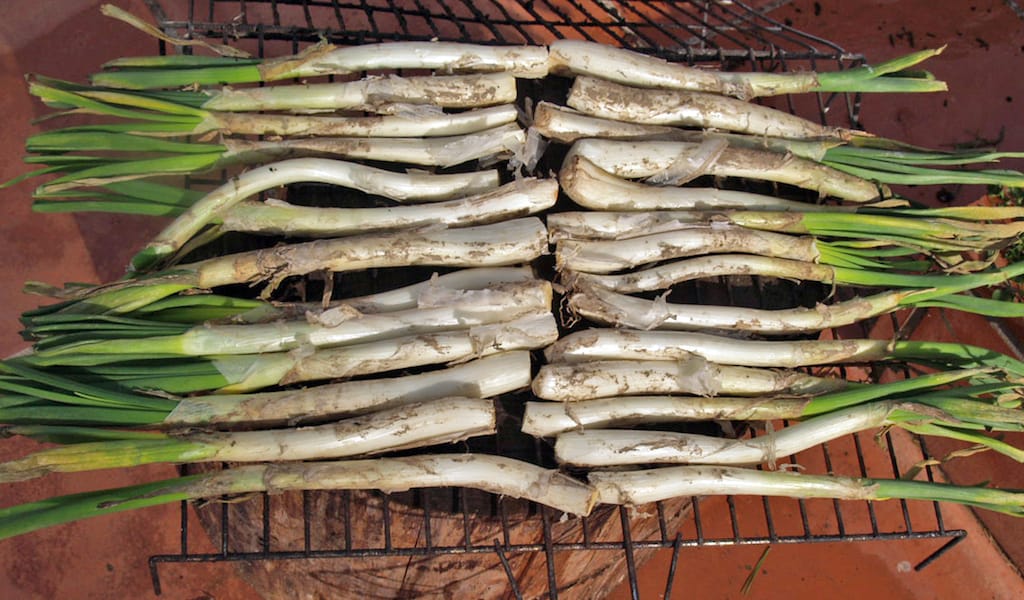For thousands of years, snails have been an easy source of protein, particularly during lean times. But for the Romans, these slimy mollusks were more than just a back up – a meal of snails was considered an exquisite feast.
The Romans were experts on the subject. They studied and classified snails; they knew where to find the edible species in the south of France, Greece, Italy and Spain, how to farm them, how to clean and prepare them and, of course, how to cook them. Records show that the snails were roasted with different seasonings, like garum, pepper or olive oil, or cooked in wine. In fact, the Romans were so enamored with snails that they designed a special spoon with a spike at the end of the handle, called a cochlearium, to better eat them with.
Outside of the Romans, the use of snails as an ingredient in Spain was documented as early as the 11th century, in a recipe for rabbit with snails that was allegedly enjoyed by the caliph Muhammad ibn Abbad al-Mu’tamid of Seville. Since then these mollusks, called cargols in Spanish, have appeared in innumerable recipes across what is modern-day Spain.
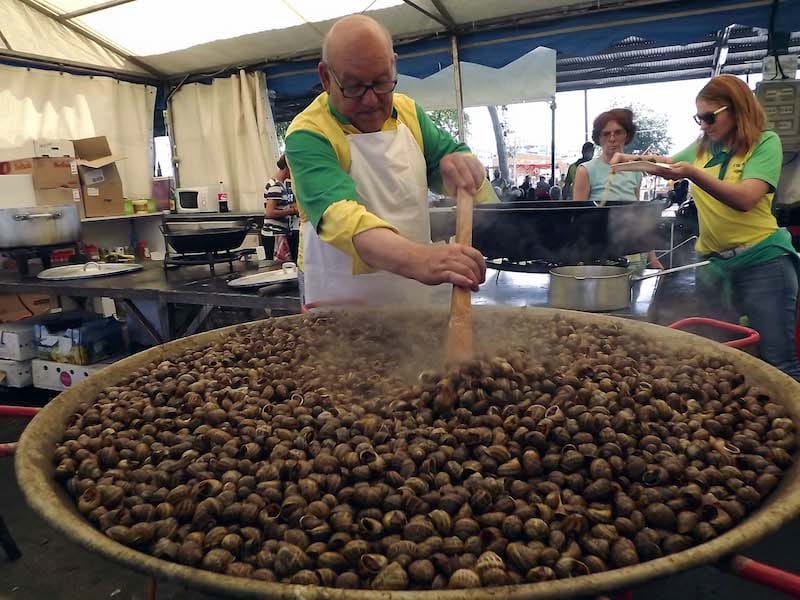
One of the best-known snail species is the Helix pomatia (known as the “Burgundy” snail), which is what you’ll most likely be served in France. But in kitchens across Spain and Catalonia, the smaller, less meaty Helix aspersa, known in Catalan and Spanish as caragol bover and also called a garden snail (petit gris in French), is more popular. Low in fat and calories and rich in minerals and proteins, the snail is an old staple with a newfound popularity – while perhaps not as obsessed as the Romans were, Catalans are rediscovering all the benefits of snails: they’re nutritious, tasty and easy to raise.
Spain has seen a huge growth in snail cultivation over the past few decades, from 26 farms in 2000 to more than 200 in 2018. According to data from Spain’s Ministry of Agriculture, Food and Environment, Spaniards eat around 16 millions kilos of snails per year, second only to France; a large percentage are consumed in Andalucía, Valencia and Catalonia, regions where there’s a tradition of hunting for snails in the wild (many people still consider foraged snails to be tastier than their cultivated counterparts). In these areas, it’s easy to find snails in taverns, bars and traditional restaurants, either on their own or as an ingredient in a tapa, starter or first course.
Each May, the city of Lleida, located in the center of Catalonia, plays host to Spain’s largest culinary event dedicated to snails: L’Aplec del Caragol. The three-day festival, which has been held annually since 1980, brings together 12,000 registered “snail clubs,” with each club cooking up their own snail specialties on the banks of the Segre River. Around 200,000 visitors come to nosh on the magical snail creations that come from the clubs’ grills, which are accompanied by liters of wine, music, parades and other activities.
Low in fat and calories, and rich in minerals and proteins, the snail is an old staple with a newfound popularity.
Like mushrooms, snails belong to a category of “wild” ingredients that feature prominently in traditional Catalan recipes. In Barcelona restaurants and bars, you’re likely to find a few classic Catalan preparations, such as snails a la catalana, a typical tapa where the snails are served in a thick, tasty sauce of tomatoes with finely chopped onion and red bell peppers, almonds or pine nuts, chopped ham or pancetta, and chorizo with paprika.
Another traditional Catalan dish is snails a la llauna, where the snails are cooked in a metal roasting tray on a charcoal grill or in the oven, dressed with salt and pepper, olive oil and herbs like oregano, and then served with dipping sauces, usually either allioli (aioli) or romesco.
Another excellent traditional dish is the stew of rabbit with snails (conill amb cargols in Catalan or conejo con caracoles in Spanish) in a succulent sofrito sauce made of garlic, onion, tomato and herbs. There are lots of variations on this classic, with some adding minced nuts (picada) to the sauce; we’ve even seen one take where the sauce had a touch of chocolate, which made it really sing.
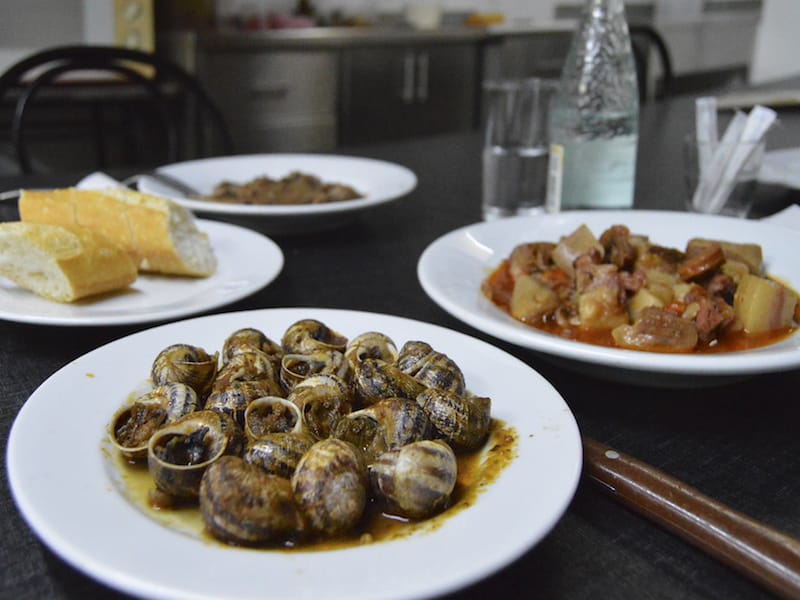
To finish, another delicious preparation that you’re sure to see in traditional Catalan restaurants is the snails a la gormanda, boiled with aromatic herbs like bay leaves, fennel or thyme, then flambéed in brandy and pan-fried with flour and more herbs, salt and pepper.
All of these dishes are magnificent options for enjoying this exquisite ingredient. Whatever the preparation, you’ll always need a snail fork to remove a snail from its shell. But the pleasure doesn’t end once you’ve popped the little mollusk in your mouth – licking the shells (and then your fingers) is a gustatory experience in its own right.
As for the best places to eat cargols in Barcelona, Cal Boter has at least three snail dishes on the menu at all times – this family-run restaurant serving traditional Catalan cuisine in Gràcia is a favorite of ours. Bodega Bartolí, which opened in 1939 as a little bulk wine shop in Barcelona’s Sants neighborhood, always has a snails tapa available although the lunch menu changes daily. Finally, Can Cargol in L’Eixample and El Pebrot i el Petit Cargol in Sants both specialize in snails and grilled dishes.
Editor’s note: Our recurring Building Blocks feature focuses on foods and ingredients that are fundamental to the cuisines we write about.
This article was originally published on May 24, 2018.
Published on May 12, 2021
Related stories
May 24, 2018
BarcelonaFor thousands of years, snails have been an easy source of protein, particularly during lean times. But for the Romans, these slimy mollusks were more than just a back up – a meal of snails was considered an exquisite feast. The Romans were experts on the subject. They studied and classified snails; they knew where…
Spend a day with us in Sants, feasting off the grid!
March 8, 2019
BarcelonaThe trick to cooking calçots, a special Catalan spring onion, is simple: a good charcoal grill. The heat from the glowing embers is crucial to creating the perfectly scorched exterior (the black outer skin is then peeled away, leaving the tender and juicy inner bulb). Fire and smoke – along with exceptionally fresh green onions…
May 3, 2021
BarcelonaBars, cafés, taverns and restaurants have historically functioned as meeting spots for all kinds of urban communities, from intellectuals to politicians and artists –revolutions have even been planned around the table. Nowadays in Barcelona, another community, one that has flourished in numerous cities around the world, has started gathering in these types of venues: cyclists.…







































